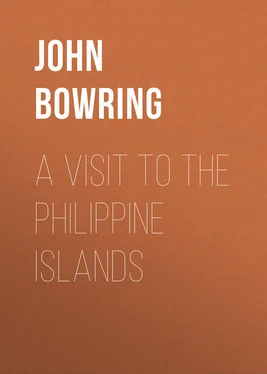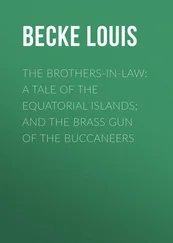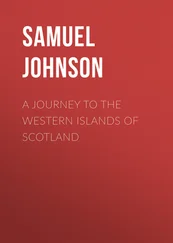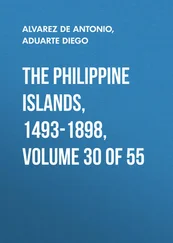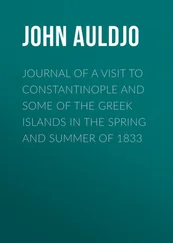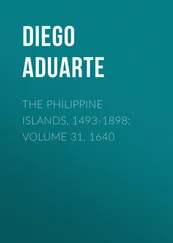John Bowring - A Visit to the Philippine Islands
Здесь есть возможность читать онлайн «John Bowring - A Visit to the Philippine Islands» — ознакомительный отрывок электронной книги совершенно бесплатно, а после прочтения отрывка купить полную версию. В некоторых случаях можно слушать аудио, скачать через торрент в формате fb2 и присутствует краткое содержание. Жанр: foreign_antique, foreign_prose, на английском языке. Описание произведения, (предисловие) а так же отзывы посетителей доступны на портале библиотеки ЛибКат.
- Название:A Visit to the Philippine Islands
- Автор:
- Жанр:
- Год:неизвестен
- ISBN:нет данных
- Рейтинг книги:3 / 5. Голосов: 1
-
Избранное:Добавить в избранное
- Отзывы:
-
Ваша оценка:
- 60
- 1
- 2
- 3
- 4
- 5
A Visit to the Philippine Islands: краткое содержание, описание и аннотация
Предлагаем к чтению аннотацию, описание, краткое содержание или предисловие (зависит от того, что написал сам автор книги «A Visit to the Philippine Islands»). Если вы не нашли необходимую информацию о книге — напишите в комментариях, мы постараемся отыскать её.
A Visit to the Philippine Islands — читать онлайн ознакомительный отрывок
Ниже представлен текст книги, разбитый по страницам. Система сохранения места последней прочитанной страницы, позволяет с удобством читать онлайн бесплатно книгу «A Visit to the Philippine Islands», без необходимости каждый раз заново искать на чём Вы остановились. Поставьте закладку, и сможете в любой момент перейти на страницу, на которой закончили чтение.
Интервал:
Закладка:
John Bowring
A Visit to the Philippine Islands
PREFACE
The Philippine Islands are but imperfectly known. Though my visit was a short one, I enjoyed many advantages, from immediate and constant intercourse with the various authorities and the most friendly reception by the natives of every class.
The information I sought was invariably communicated with courtesy and readiness; and by this publication something will, I hope, be contributed to the store of useful knowledge.
The mighty “tide of tendency” is giving more and more importance to the Oriental world. Its resources, as they become better known, will be more rapidly developed. They are promising fields, which will encourage and reward adventure; inviting receptacles for the superfluities of European wealth, activity, and intelligence, whose streams will flow back upon their sources with ever-augmenting contributions. Commerce will complete the work in peace and prosperity, which conquest began in perturbation and peril. Whatever clouds may hang over portions of the globe, there is a brighter dawning, a wider sunrise, over the whole; and the flights of time, and the explorings of space, are alike helping the “infinite progression” of good.
J. B.CHAPTER I
MANILA AND NEIGHBOURHOOD
Three hundred and forty years ago, the Portuguese navigator Fernando de Magalhães, more generally known by his Spanish designation Magellanes, proposed to Carlos I. an expedition of discovery in the Eastern seas. The conditions of the contract were signed at Zaragoza, and, with a fleet of six vessels, the largest of which was only 130 tons burden, and the whole number of the crews two hundred and thirty-four men, Magalhães passed the straits which bear his name in November, 1520; in the middle of March of the following year he discovered the Mariana Islands, and a few days afterwards landed on the eastern coast of the island of Mindanao, where he was well received by the native population. He afterwards visited the island of Zebu, where, notwithstanding a menaced resistance from more than two thousand armed men, he succeeded in conciliating the king and his court, who were not only baptized into the Catholic faith, but recognised the supreme sovereignty of the crown of Spain, and took the oaths of subjection and vassalage. The king being engaged in hostilities with his neighbours, Magalhães took part therein, and died in Mactan, on the 26th April, 1521, in consequence of the wounds he received. This disaster was followed by the murder of all the leading persons of the expedition, who, being invited to a feast by their new ally, were treacherously assassinated. Guillen de Porceleto alone escaped of the twenty-six guests who formed the company. Three of the fleet had been lost before they reached the Philippines; one only returned to Spain – the Vitoria – the first that had ever made the voyage round the world, and the Spanish king conferred on her commander, Elcano, a Biscayan, an escutcheon bearing a globe, with the inscription, “Primus circumdedit me.” A second expedition, also composed of six vessels and a trader, left Spain in 1524. The whole fleet miserably perished in storms and contests with the Portuguese in the Moluccas, and the trader alone returned to the Spanish possessions in New Spain.
About one hundred and twenty of the expedition landed in Tidore, where they built themselves a fortress, and were relieved by a third fleet sent by Hernan Cortes, in 1528, to prosecute the discoveries of which Magalhães had had the initiative. This third adventure was as disastrous as those which had preceded it. It consisted of three ships and one hundred and ten men, bearing large supplies and costly presents. They took possession of the Marianas (Ladrone Islands) in the name of the king of Spain, reached Mindanao and other of the southern islands, failed twice in the attempt to reach New Spain, and finally were all victims of the climate and of the hostility of the Portuguese.
But the Spanish court determined to persevere, and the Viceroy (Mendoza) of New Spain was ordered to prepare a fourth expedition, which was to avoid the Molucca Islands, where so many misfortunes had attended the Spaniards. The fleet consisted of three ships and two traders, and the commander was Villalobos. He reached the Archipelago, and gave to the islands the name of the Philippines, in honour of the Prince of Asturias, afterwards Philip the Second. Contrary winds (in spite of the royal prohibition) drove them into the Moluccas, where they were ill received by the Portuguese, and ordered to return to Spain. Villalobos died in Amboyna, where he was attended by the famous missionary, St. Francisco Xavier. Death swept away many of the Spaniards, and the few who remained were removed from the Moluccas in Portuguese vessels.
A fifth expedition on a larger scale was ordered by Philip the Second to “conquer, pacify, and people” the islands which bore his name. They consisted of five ships and four hundred seamen and soldiers, and sailed from La Natividad (Mexico) in 1564, under the orders of Legaspi, who was nominated Governor of the Philippines, with ample powers. He reached Tandaya in February, 1565, proceeded to Cabalian, where the heir of the native king aided his views. In Bojol, he secured the aid and allegiance of the petty sovereigns of the island, and afterwards fixed himself on the island of Zebu, which for some time was the central seat of Spanish authority. 1 1 A recent History of the Conquest of the Islands, and of the Spanish rule, is given by Buzeta, vol. i., pp. 57–98.
Manila was founded in 1581.
Illness and the despotism of the doctors, who ordered me to throw off the cares of my colonial government and to undertake a sea voyage of six or seven weeks’ duration, induced me to avail myself of one of the many courtesies and kindnesses for which I am indebted to the naval commander-in-chief, Sir Michael Seymour, and to accept his friendly offer of a steamer to convey me whither I might desire. The relations of China with the Eastern Spanish Archipelago are not unimportant, and were likely to be extended in consequence of the stipulations of Lord Elgin’s Tientsin Treaty. Moreover, the slowly advancing commercial liberalism of the Spaniards has opened three additional ports to foreign trade, of which, till lately, Manila had the monopoly. I decided, therefore, after calling at the capital in order to obtain the facilities with which I doubted not the courtesy of my friend Don Francisco Norzagaray, the Captain-General of the Philippines, would favour me, to visit Zamboanga, Iloilo, and Sual. I had already experienced many attentions from him in connection with the government of Hong Kong. It will be seen that my anticipations were more than responded to by the Governor, and as I enjoyed rare advantages in obtaining the information I sought, I feel encouraged to record the impressions I received, and to give publicity to those facts which I gathered together in the course of my inquiries, assisted by such publications as have been accessible to me.
Sir Michael Seymour placed her Majesty’s ship Magicienne at my disposal. The selection was in all respects admirable. Nothing that foresight could suggest or care provide was wanting to my comfort, and I owe a great deal to Captain Vansittart, whose urbanities and attentions were followed up by all his officers and men. We left Hong Kong on the 29th of November, 1858. The China seas are, perhaps, the most tempestuous in the world, and the voyage to Manila is frequently a very disagreeable one. So it proved to us. The wild cross waves, breaking upon the bows, tossed us about with great violence; and damage to furniture, destruction of glass and earthenware, and much personal inconvenience, were among the varieties which accompanied us.
Читать дальшеИнтервал:
Закладка:
Похожие книги на «A Visit to the Philippine Islands»
Представляем Вашему вниманию похожие книги на «A Visit to the Philippine Islands» списком для выбора. Мы отобрали схожую по названию и смыслу литературу в надежде предоставить читателям больше вариантов отыскать новые, интересные, ещё непрочитанные произведения.
Обсуждение, отзывы о книге «A Visit to the Philippine Islands» и просто собственные мнения читателей. Оставьте ваши комментарии, напишите, что Вы думаете о произведении, его смысле или главных героях. Укажите что конкретно понравилось, а что нет, и почему Вы так считаете.
